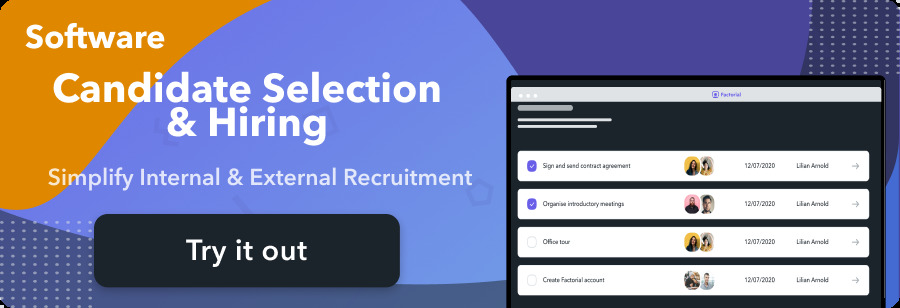HR best practices are a set of processes and techniques that have been proven by research and experience to produce increased business performance results. They are internal guidelines that a company establishes to streamline procedures and obtain optimum results in all business areas. This guide will serve to explain what they entail, what activities can they be applied to, and why they are so important.
- 💪 Key HR Responsibilities
- 🙌 Best Practices in HR
- 😃 Examples of best HR practices
- 😎 Companies with HR best practices
What are the 7 Major HR Activities?
The HR team is responsible for a number of core activities within a company relating to the wellbeing and fair treatment of employees. This includes recruitment and selection, employee retention, training, and compensating staff. Human resources best practices can be applied to all these activities to help the HR department reach their full potential and obtain optimum business results.
Let’s start by taking a look at the principal activities of the Human Resources department.
Recruitment
Writing job descriptions, recruiting new employees, hiring contractors and terminating employee contracts. Negotiating salaries and benefits and complying with regulations relating to the hiring process.
Employee Relations
Defending employee rights, mediating claims (including complaints relating to harassment) and coordinating with labor unions.
Health & Safety
Implementing safety measures, ensuring compliance with H&S legal requirements, recording and investigating all workplace incidents and accidents, and processing claims for workers’ compensation.
Labor Law Compliance
Adhering to labor and compliance laws, ensuring employees are treated fairly and legally, and staying up to date with state and federal employment laws.
Compensation Planning
Defining and processing payroll, salary and benefits based on role, performance and legal requirements. Managing employee insurance, pensions, and other third-party employee benefits.
Training & Development
Providing continuous professional development for employees to keep employee skills and experience up to date. Training new employees.
Performance Management
Monitoring and analyzing individual, team and overall company performance in line with goals and objectives. Performance management software can be used to streamline and optimize the performance review process.
What Are Human Resources Best Practices?
Best practices are commercial or professional procedures that are accepted and promoted as being correct and effective. They are guidelines, ethics and ideas that represent the most efficient course of action in any given situation and they take into account all HR processes.
The best practices in human resources management align with the company’s goals and objectives and provide added value to the business as a whole.
Policies and procedures should include:
- HR communications best practices
- Human Resources automation best practices
- HRM analytics best practices
- HR best practices for interviewing and hiring
- Best practices in employee engagement
Benefits of implementing good hr practices:
- Increase employee productivity
- Maintain organisational culture and ensure all employees are a good fit
- Improve employee retention and corporate reputation
- Increase employee satisfaction as employees feel supported and motivated
- Continuous improvement in terms of professional development and business strategy
- Improve talent management
- Monitor progress to ensure company goals and objectives are reached

How can HR Practices be Improved?
The best HR policies support each stage of a business’s development and growth. The first step to success is ensuring there are clear company goals. A strategy then needs to be designed that identifies all business needs and establishes clear guidelines so that employees are aware of their role and what is expected of them. To ensure success, HR professionals should design a human resources best practices checklist.
HR Best Practices Examples
Healthy Environment
create a safe, happy and healthy environment for employees. Encourage equal and open discussions, celebrate team wins and set boundaries and expectations. Show appreciation and encourage positive thinking. Happy employees are far more likely to stay at a company and perform to the best of their ability.
Performance Linked Bonuses
Incentivize employees with performance-based rewards and bonuses. Establish clear metrics and KPIs so that all employees are aware of how their individual performance impacts on the profitability of the company. A well-designed performance linked bonus scheme motivates managers and employees to improve efficiency and productivity and increases accountability.
Encourage Employee Feedback
Recognize, nurture and execute employee feedback. Encourage open discussions and the use of suggestion boxes. Conduct regular surveys to gather the thoughts and ideas of employees so that they feel valued and involved in the overall success of the business. Surveys can be conducted through performance management software. The right questions can help you evaluate the interest, motivation and overall happiness of your employees and make any necessary changes. This, in turn, can help improve the corporate culture and increase employee retention.
Ongoing Training
Establish clear procedures for the continuous professional development of all employees. Regularly analyse business needs to identify gaps and implement appropriate training programs. Ensure your company takes training costs into account when they calculate the annual budgets in their HR plan. An organization that offers ongoing training for employees will have low turnover because the workforce is loyal.
Companies with Best HR Practices
Companies that design and implement an effective best practice HR strategy are more likely to increase profits, retain staff and improve quality and productivity. There are many examples of this in the corporate world. Here are some of our favorites.
FedEx
Employees at FedEx are an integral part of the decision-making process. The company practices a “People-Service-Profit” philosophy focused on the care and wellbeing of its employees. The company conducts an annual Survey-Feedback-Action to track employee satisfaction, collect suggestions, and improve working conditions. Employees then meet to discuss results, address issues and propose solutions as a group. The philosophy acknowledges the importance of employee satisfaction and empowerment to create an environment where employees feel secure enough to take risks and become innovative in pursuing quality, service and customer satisfaction.
AMX
AMX, an American manufacturer of video switching and control devices owned by Samsung, promotes trust and communication between staff and provides an open-space working environment for this purpose. The company prides itself on conscientious hiring and layoff practices, offering generous severance packages and helping place employees in new companies in the event of layoffs.
OXFAM
As a charity, Oxfam is unable to compete on salaries and benefits. It has therefore re-focused its energies on employee training and development. It views its staff as vital assets for the company and invests in training so that employees share their core beliefs and values and strive to develop their skills and experience.
Designing and implementing HR best practices such as those discussed in this article will help your employees strive for excellence, establish clear objectives and guidelines, and ultimately increase productivity and profitability for your organization.
Implement HR Best Practices into your workplace by first steamlining your HR Processes w/ Factorial HR
Written by Cat Symonds; Edited by Tanya Lesiuk


